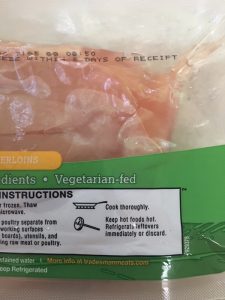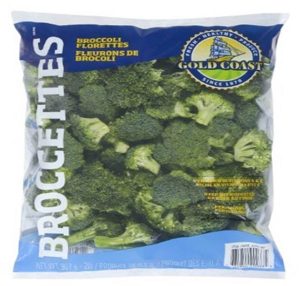Katrina Levine, extension associate and lead author of Consumer perceptions of the safety of ready-to-eat foods in retail food store settings writes,
While I was grocery shopping one day at my regular store, I noticed that one of the doors to the dairy refrigerator case was missing. There was no sign or notice to explain the gaping hole where the door should have been in front of the shredded cheese, nor was any attempt made to compensate for the absent door, such as by relocating the items in that section or putting up a temporary covering.
After first being a bit confused when trying to reach for a non-existent handle, these questions popped into my head:
• how can the food in this section be at a safe temperature, as well as the foods on either side of it? and,
• doesn’t this missing door affect the ability of the case to maintain its temperature?
I’m a food safety nerd. Most people just want to shop and get on with whatever they are doing, but I’m subconsciously always looking for food safety behaviors. The person standing behind me was probably more interested in which brand was the least expensive or which package looked the freshest, or just wanted me to get out the way so they could buy their cheese and leave.
Does the lack of a door on a normally enclosed refrigerator case pose a food safety risk for dairy the products in that case? Depends on whom you ask. The average consumer (interpret this as you choose) often doesn’t see the same food safety risks when shopping in grocery stores compared to food safety folks.
Our group from North Carolina State teamed up with John Luchansky and Anna Porto-Fett at the U.S. Department of Agriculture’s Agricultural Research Service to investigate this difference between consumers and food safety folks in food safety risk perception when shopping at grocery stores. We conducted a national survey and several focus groups where, instead of just describing a situation, we showed pictures of a food safety situation someone could actually encounter while shopping. In addition to asking questions about whether each photo was safe or unsafe, we wanted to know about the actions, if any, people would take to do something about a situation they thought was unsafe. We prodded them further with questions about how their perceptions of safety would affect their shopping behaviors.
We found that consumers and food safety folks don’t always see the same food safety risks. There were some situations consumers perceived as risky but that weren’t actually risks, like seeing an insect on the floor. There were also some risks that food safety folks saw but consumers missed, like food not properly stored within the refrigerated area.
I was explaining our study to a friend the other day, and she flat out told me, “I look for food quality when I’m shopping – is it fresh, is there mold or signs of damage, does it look ok?” This is exactly what we found. Consumers are looking for those quality aspects, but aren’t always seeing the warning signs that the safety of the food could be at risk. The viruses, bacteria, and other things that cause foodborne illness such as Listeria monocytogenes, might be present on foods in the grocery store at high levels by not storing soft cheeses at the proper temperature, allowing bacteria to grow more quickly.
Our research team will be taking this one step further to better understand the mind of the shopper and see things through their eyes. Everyday consumers will become our secret shoppers, and we plan to arm them with the information they need to be food safety detectives every time they shop. #citizenscience for the win.
Consumer perceptions of the safety of ready-to-eat foods in retail food store settings
Katrina Levine, Mary Yavelak, John B. Luchansky, Anna C. S. Porto-Fett, and Benjamin Chapman
Journal of Food Protection
August 2017, Vol. 80, No. 8, pp. 1364-1377
DOI: doi.org/10.4315/0362-028X.JFP-16-417
Abstract:
To better understand how consumers perceive food safety risks in retail food store settings, a survey was administered to 1,041 nationally representative participants who evaluated possible food safety risks depicted in selected photographs and self-reported their perceptions, attitudes, and behaviors. Participants were shown 12 photographs taken at retail stores portraying either commonly perceived or actual food safety contributing factors, such as cross-contamination, product and equipment temperatures, worker hygiene, and/or store sanitation practices. Participants were then asked to specifically identify what they saw, comment as to whether what they saw was safe or unsafe, and articulate what actions they would take in response to these situations. In addition to the survey, focus groups were employed to supplement survey findings with qualitative data. Survey respondents identified risk factors for six of nine actual contributing factor photographs >50% of the time: poor produce storage sanitation (86%, n = 899), cross-contamination during meat slicing (72%, n = 750), bare-hand contact of ready-to-eat food in the deli area (67%, n = 698), separation of raw and ready-to-eat food in the seafood case (63%, n = 660), cross-contamination from serving utensils in the deli case (62%, n = 644), and incorrect product storage temperature (51%, n = 528). On a scale of 1 to 5, where 1 was very unsafe and 5 was very safe, a significant difference was found between average risk perception scores for photographs of actual contributing factors (score of ca. 2.5) and scores for photographs of perceived contributing factors (score of ca. 2.0). Themes from the focus groups supported the results of the survey and provided additional insight into consumer food safety risk perceptions. The results of this study inform communication interventions for consumers and retail food safety professionals aimed at improving hazard identification.












